Food repeats itself
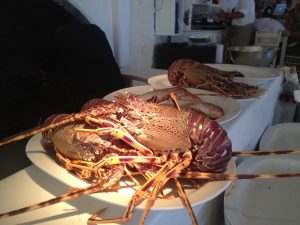 Gastronomy culture travels along with the people. The same dish made with fish is called Buğulama (Fish Stew) in Turkey, Burdeto in Greece only a few hundred miles away, Brodetto in Venice after a couple of strokes in Adriatic Sea, Bouillabaisse in France if you take a few more steps and Suguet, or “fish juice” in Spain, named after the Italian obsession “Sugo” which is our very same suffix “Suyu – Juice”. We still cook the same meal that traveled for centuries from one region to another. It’s the same fish and the same meat. Food, as history, repeats itself.
Gastronomy culture travels along with the people. The same dish made with fish is called Buğulama (Fish Stew) in Turkey, Burdeto in Greece only a few hundred miles away, Brodetto in Venice after a couple of strokes in Adriatic Sea, Bouillabaisse in France if you take a few more steps and Suguet, or “fish juice” in Spain, named after the Italian obsession “Sugo” which is our very same suffix “Suyu – Juice”. We still cook the same meal that traveled for centuries from one region to another. It’s the same fish and the same meat. Food, as history, repeats itself.
What comes to your mind first when you are mentioend Greek cuisine?
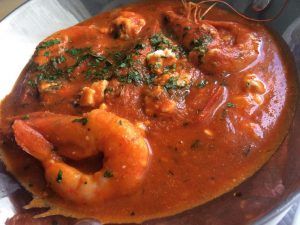 Octopus, squid, but above all, moussaka comes first to my mind. There’s for sure a lot more and authentic dish to count. Think of this like that;
Octopus, squid, but above all, moussaka comes first to my mind. There’s for sure a lot more and authentic dish to count. Think of this like that;
If I asked you about the Italian cuisine, even the farthest person from the subject would answer Pasta. Makarna is the Turkish word for Pasta, just like macaroni. The most conscious one would answer Linguini, Spaghetti or Tagliatelle, but these are all words for the dough with different thickness or shape, and believe me there’re tens of more different types of “pasta”. Yes, Italy generalizes this food with the word “Pasta” which means “dough”. And it has nothing to do our Çikolatalı Pasta (Chocolate Cake) or muzlu pasta (banana cake) as “pasta” means cake in Turkey.
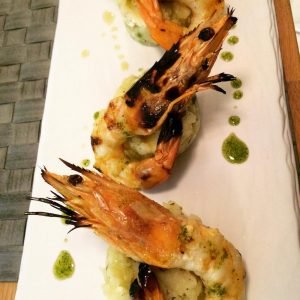 But still, even though it has various sauces, shapes or names, is Pasta enough to describe the Italian cuisine which has hundreds of recipes from all those regions? No, it doesn’t. Most of all Pizza! Even though Pizza is now an Italian trademark, it is in fact a Neapolitan street food. Italian pizza diners are called Pizzeria, not restaurants. Italian culinary schools do not teach making Pizza. Because making Pizza is the masters’ business. Just like our Lahmacun! Lahmacun originates from one region only and you have it in a lahmacuncu (diner that sells lahmacun), just like you eat kebap in a kebapçı (diner that sells kebap). Best lahmacun is made by its master. It can’t be found in Turkish cuisine literature, just like the pizza case. But if you ask anyone outside of Italy, you get the answer Pizza and pasta for Italian and kebap and lahmacun for Turkish cuisines.
But still, even though it has various sauces, shapes or names, is Pasta enough to describe the Italian cuisine which has hundreds of recipes from all those regions? No, it doesn’t. Most of all Pizza! Even though Pizza is now an Italian trademark, it is in fact a Neapolitan street food. Italian pizza diners are called Pizzeria, not restaurants. Italian culinary schools do not teach making Pizza. Because making Pizza is the masters’ business. Just like our Lahmacun! Lahmacun originates from one region only and you have it in a lahmacuncu (diner that sells lahmacun), just like you eat kebap in a kebapçı (diner that sells kebap). Best lahmacun is made by its master. It can’t be found in Turkish cuisine literature, just like the pizza case. But if you ask anyone outside of Italy, you get the answer Pizza and pasta for Italian and kebap and lahmacun for Turkish cuisines.
It is therefore a shame to oversimplify the Greek cuisine by mentioning only Moussaka, octopus salad in vinegar, dried octopus grill, Tzatziki and Greek salad found in any touristic restaurant. Greek cuisine is a lot more than that.
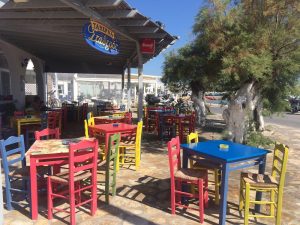 The names also sound familiar in Turkish? Moussaka is our Aubergine Moussaka with béchamel sauce, while the Turkish word for it is Musakka; not similar at all ☺… Octopus salad is the same version found in our fish restaurants in Turkey, and Tzatziki is the usual, only a little denser Cacık! Saganaki is the technique for cooking and presenting the food, what we call “Sahanda!”. The renown Feta cheese in the Greek salad is our white cheese, only Feta became global! It’s a little harder. This is all very normal. We share the same sea, same water and same shores. And even though they use another alphabet, we use the same language. Portakal in Turkish (orange) is pronounced as Portakali and Karpuz (watermelon) is pronounced as Karpuzi.
The names also sound familiar in Turkish? Moussaka is our Aubergine Moussaka with béchamel sauce, while the Turkish word for it is Musakka; not similar at all ☺… Octopus salad is the same version found in our fish restaurants in Turkey, and Tzatziki is the usual, only a little denser Cacık! Saganaki is the technique for cooking and presenting the food, what we call “Sahanda!”. The renown Feta cheese in the Greek salad is our white cheese, only Feta became global! It’s a little harder. This is all very normal. We share the same sea, same water and same shores. And even though they use another alphabet, we use the same language. Portakal in Turkish (orange) is pronounced as Portakali and Karpuz (watermelon) is pronounced as Karpuzi.
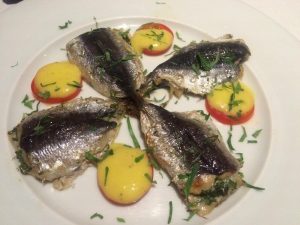 The best food to have on the Greek islands is naturally sea food. These guys just know how to cook all types of sea food to a turn. Their most commonly used method is grill. On huge grills, they grill any kind of fish, shellfish or squid. Don’t take it for granted! If you cook these creatures, just a click more they become as tough as old shoe leather! So consistency is crucial. Another favorite seafood of Greeks is the octopus. Every restaurant has octopuses hung on a hook to the ceiling. These octopuses are beautifully dried in the sun with the effect of the wind and their own salt water. Then the cook grills them and serves. Tastes differ for every person. You can’t grill them to a soft taste without boiling them first. They’re a little tougher but because of the sea salt inside, it has a different taste of the sea.
The best food to have on the Greek islands is naturally sea food. These guys just know how to cook all types of sea food to a turn. Their most commonly used method is grill. On huge grills, they grill any kind of fish, shellfish or squid. Don’t take it for granted! If you cook these creatures, just a click more they become as tough as old shoe leather! So consistency is crucial. Another favorite seafood of Greeks is the octopus. Every restaurant has octopuses hung on a hook to the ceiling. These octopuses are beautifully dried in the sun with the effect of the wind and their own salt water. Then the cook grills them and serves. Tastes differ for every person. You can’t grill them to a soft taste without boiling them first. They’re a little tougher but because of the sea salt inside, it has a different taste of the sea.
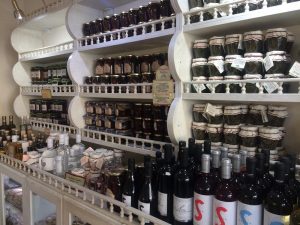 Looking at it from Turkish coast of the sea, you get vexed at being left so ignorant on cooking sea food. Let alone knowing how to cook, there isn’t even a proper sales technique. In a Turkish fish restaurant, order mussels and you hardly find anything else than the rice stuffed traditional version. The big jumbo shrimp are rare and very pricy. Thankfully, we also like octopus but for whatever reason strip off the most delicious buttons and make a cold octopus salad out of it, and don’t even think of an alternative way of cooking.
Looking at it from Turkish coast of the sea, you get vexed at being left so ignorant on cooking sea food. Let alone knowing how to cook, there isn’t even a proper sales technique. In a Turkish fish restaurant, order mussels and you hardly find anything else than the rice stuffed traditional version. The big jumbo shrimp are rare and very pricy. Thankfully, we also like octopus but for whatever reason strip off the most delicious buttons and make a cold octopus salad out of it, and don’t even think of an alternative way of cooking.
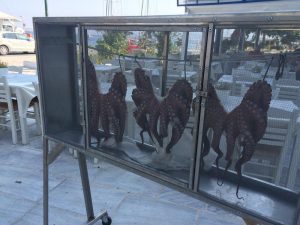 So what else did I come across in Cyclades? Well, cheese of course. Cheese is such a bizarre food that every region has its own type of cheese that goes with its own name. Again, we can’t limit cheese to the Italian Parmigiano, Greek Feta, French Roquefort or Turkish Ezine white cheese. There are hundreds of different types. And the Greeks have different cheese peculiar to every island.
So what else did I come across in Cyclades? Well, cheese of course. Cheese is such a bizarre food that every region has its own type of cheese that goes with its own name. Again, we can’t limit cheese to the Italian Parmigiano, Greek Feta, French Roquefort or Turkish Ezine white cheese. There are hundreds of different types. And the Greeks have different cheese peculiar to every island.
The most famous are Feta and Mizithra. I have no idea for whichever political or economic reason we can’t promote our Ezine or Thrace-origin white cheese which taste a lot better than Feta as successfully, but Feta is found almost anywhere from the Caribbean to the tiniest grocery in the most remote country.
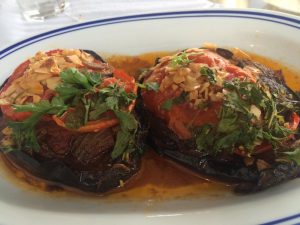 Greek cheese is very similar to Turkish cheese. What I mean is the texture and taste is closer to the white Turkish cheese rather than the European ones. They’re mostly made from sheep and goat milk. Again they’re mostly Crete-origin which is significant in Greek history, and get diversified in the islands. Anthotyros, Galotiri, Graviera, Kasseri, Kefalograviera, Kefalotyrı, Kapnisto Metsovone, Ladotyri, Manouri, Metsovone; these are all cheese that you’ve probably never heard of. And you find the Turkish Hellim cheese from Cyprus under the name of Halloumi. Another interesting memory is that I’ve actually found Halloumi unexpectedly in a small grocery in Antigua & Barbuda on the corner of West Atlantic, when you wouldn’t even happen to find the famous Parmesan of Italy.
Greek cheese is very similar to Turkish cheese. What I mean is the texture and taste is closer to the white Turkish cheese rather than the European ones. They’re mostly made from sheep and goat milk. Again they’re mostly Crete-origin which is significant in Greek history, and get diversified in the islands. Anthotyros, Galotiri, Graviera, Kasseri, Kefalograviera, Kefalotyrı, Kapnisto Metsovone, Ladotyri, Manouri, Metsovone; these are all cheese that you’ve probably never heard of. And you find the Turkish Hellim cheese from Cyprus under the name of Halloumi. Another interesting memory is that I’ve actually found Halloumi unexpectedly in a small grocery in Antigua & Barbuda on the corner of West Atlantic, when you wouldn’t even happen to find the famous Parmesan of Italy.
If you stop by the Greek islands and order a cheese plate, let the waiter tell you what’s inside. They would be delighted to give you information.
What else to eat?
- Meatball is famous, like in Turkey. Keftedakia for instance. Unlike the European cuisine, they knead the meatballs with wetted stale bread like Turkish mothers do, but only they are not in good terms with cumin. They add mint, thyme and a little lemon juice.
- For the mezes, they have Louloudokeftedes, fried squash blossoms stuffed with cheese.
- And the good old Turkish Mücver! Its name is Kolokythokeftedes. Keftedes as you can guess meatballs, (we call it Kofte in Turkish, what a coincidence again!) and this is basically zucchini cake. The rest of Europe and even America makes mücver but call it zucchini cake while the shape and taste differentiates to the content. But the Greek Mücver is exactly the same with Turkish one. They also add potato inside.
- Taramo keftedes, or balls of Tarama in Turkish. The fried ball version of tarama made of fish roe.
- Kremydokeftedes. Onion balls. (yes you must know well by now that Greeks like it fried…).
- Dolmades! Guess what it is? Dolmades Yialantzi is stuffed vine leaves of course. Well, only the Greeks and Turks use this vine leaf. Turks call it “Dolma”, Greeks call it “Dolmades”
- Tyropitakia, Spanakopitakia, Kalitsounia are all fried pastry with spinach or cheese. Like Turkish Borek, blintze, Puff Pastry. Spanakopita is the spinach pastry on tray. I may as well say that only Greeks and Turks use this thin dough as we call filo pastry this way. You can’t find this type of pastry anywhere in Europe.
- Fava! Named same in Turkish. But don’t get it mixed up, we’re not talking about broad bean. Greeks make Fava from yellow lentils and because to the volcanic structure, the best Fava is in Santorini. Therefore, Fava is unique to Santorini as a meze that is served warm unlike Turkish which is cold.
- Our olive oil dishes are very much alike; okra in olive oil, which is not found in many other countries, exists for Greeks with the same name, Okra. They also cook artichoke the same way like Turks.
- Imam Bayıldı! Exactly the same wording. Both the name and the food are Turkish. They also cook eggplant slitted with meat filling just like Turkish “karniyarik” (minced meat stuffed eggplant) but add béchamel sauce and cook in the oven. And the name is Papoutsaika. It means “small shoe”.
- Pasta types like Kritharaki, Lazania or Hylopites as you know are inspired by the other coastal neighbors, Italians.
- Kleftiko, lamb cooked in paper in a pot.
- Lamb skewer = Paidakia
- İzmir meatballs? Just like Turkish version. The same. Its name is Soutzoukakia, originating from Smyrna as described.
- Burdeto. Sister dish of the Italian Brodetto. It is scorpion fish cooked in tomato sauce, belonging to the west, to Corfu. They also add octopus inside. If you cook it with shellfish then you get the real Brodetto, or Caccuicco as the Tuscans say, or the French Bouillabaisse. They all come to the same thing; fish stew.
- Garides Saganaki. Let’s say it in Turkish, sahanda karides (shrimp casserole)! Just like in the shrimp casserole, they cook shrimp with tomatoes and pepper, and use Feta cheese instead of Turkish cheddar to leave on top to melt.
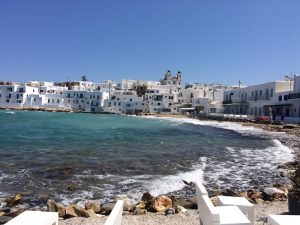 If you did not get bored and read to this end, you may come up to a conclusion, saying these people have no unique food, more than half being Turkish and the rest Italian. There you’ve made your mistake! Turks or Italians may just as well have been influenced by the Greek civilization and helped this food to travel over the seas and lands with minor variations, who knows…
If you did not get bored and read to this end, you may come up to a conclusion, saying these people have no unique food, more than half being Turkish and the rest Italian. There you’ve made your mistake! Turks or Italians may just as well have been influenced by the Greek civilization and helped this food to travel over the seas and lands with minor variations, who knows…